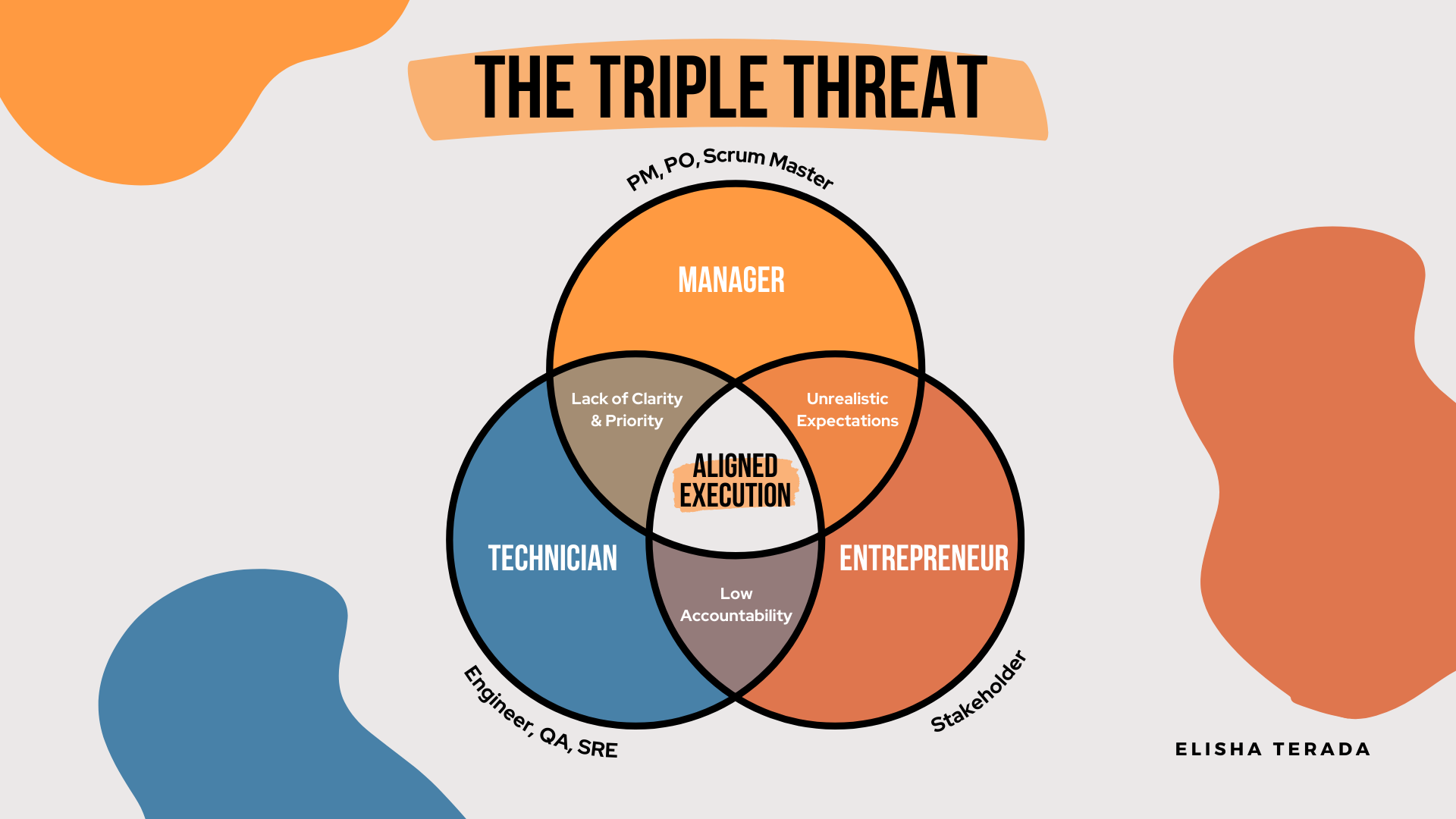The Triple Threat Inside Your Software Team: Why Your Product Isn’t Shipping Like It Should
Stalled software projects often stem from an imbalance between three roles: the Entrepreneur, Manager, and Technician. Achieving harmony between vision, organization, and execution is key to success. Without this balance, your team risks motion without progress.

Every stalled, failed, or frustrating software project often comes down to one core issue—an imbalance between three key roles: the Entrepreneur, the Manager, and the Technician. Without aligning these roles, shipping great software will feel like running in place—plenty of effort, but little forward progress.
The Triple Threat Framework: Insights from The E-Myth Revisited
In The E-Myth Revisited, Michael Gerber emphasizes that for small businesses to succeed, they must balance three critical personas:
- The Entrepreneur – Focused on innovation, vision, and long-term growth.
- The Manager – Ensures structure, processes, and organization are in place.
- The Technician – Executes the day-to-day tasks, honing their craft.
The issue arises when businesses favor one role over the others, neglecting essential perspectives. The key is to balance these three personas to create harmony, where each contributes without overshadowing the others.
This concept applies seamlessly to software teams but is often overlooked. Recognizing this "Triple Threat" within your team could be the missing link to consistently delivering successful software.
Applying the Triple Threat to Software Teams
To deliver products that users love, software teams must reflect the same balance Gerber describes. Here's how these roles translate into the software world:
- Entrepreneurs (Founders, Stakeholders, Business Leaders)
They define the product’s vision, set high-level goals, and focus on the ROI. They ask, “How will this product create value?” and push for innovation. - Managers (Product Owners, Scrum Masters, Project Managers)
They organize work, track progress, and maintain priorities. They ask, “Is the team functioning efficiently, and are we meeting our commitments?” - Technicians (Developers, Software Engineers)
They write code, solve technical problems, and incrementally build the product. They ask, “How do we implement this feature effectively?”
Why Software Teams Lose Balance
When teams lean too heavily on one of these roles, challenges inevitably arise. Here are a few common scenarios:
- Technician-Heavy Teams
Developers dive into technical challenges, aiming for perfection in the code, but lose sight of deadlines or user needs. The outcome? Flawless code that either arrives late or misses the mark. - Manager-Heavy Teams
When project managers dominate, the focus shifts to processes and timelines. Developers may feel stifled, and innovation can stall. This often results in burnout or disengagement. - Entrepreneur-Heavy Teams
Teams chase bold ideas, pivot frequently, and struggle with execution. Without balance from management or technicians, projects tend to stall or become overloaded with incomplete work.
Success comes not from addressing bottlenecks alone but from ensuring these roles are in balance. Each role brings a unique perspective that helps the team overcome challenges.
Solving Problems from Multiple Angles
When a software project hits a roadblock, it's tempting to seek a quick fix—hire more developers, change the project manager, or adjust the product vision. However, long-term success requires a more holistic approach.
- From the Entrepreneur’s View: Does the product align with the broader business goals? Are we building the right features to generate value?
- From the Manager’s View: Are processes smooth, and does the team have the support they need to meet deadlines? Is the workflow sustainable?
- From the Technician’s View: Do developers have enough space to tackle technical challenges? Are there obstacles that slow them down?
By evaluating issues from these three perspectives, teams can uncover deeper insights and craft better solutions. It may mean refining the product vision, streamlining workflows, or giving developers more room to innovate.
Achieving Balance
Shipping successful software requires all three roles—the visionary entrepreneur, the structured manager, and the skilled technician—working in harmony. When one role takes over, the team suffers, and the product struggles. The challenge is to continuously balance these roles so that no single role dominates.
Ask yourself:
- Which role is taking the lead in your team right now?
- How often does your team approach challenges from all three perspectives?
- What would it look like if your team achieved a perfect balance across these roles?
The secret to delivering software that users love isn’t just about the tools or people—it’s about finding the right balance. Which role needs more focus in your team today?
